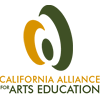Working with Elected Officials Parts 1 & 2
By Victoria Plettner-Saunders
Part 1 – What I Did on My Summer Vacation, or the Practical Application of Arts Education Advocacy
My name is Victoria Plettner-Saunders and I am one of the founders of the San Diego Alliance for Arts Education, a local advocacy network initiated by the California Alliance for Arts Education. While our formal alliance launch was in May of 2010, we actually began to gain recognition for arts education advocacy with the San Diego Unified School District (SDUSD) in June 2009 when we successfully convinced the SDUSD School Board to remove the Visual and Performing Arts Department (VAPA) from a list of things to eliminate to save money. At that time, we were a consistent presence at school board meetings and our message was clear: a) we want to be in partnership with the district on arts education issues and b) “We aren’t going away.” Here’s what that meant in reality.
In May we officially launched the San Diego Alliance for Arts Education and invited the school board president Richard Barrera to talk to our invited guests about the status of arts education in the District. By July, I’m in his speed dial and he was calling for my help. The school board is voting on Tuesday to put forth a ballot measure for a parcel tax to create local revenues for the District’s budget, he says. He wants to know if we can help by coming down to speak in support of it. He explained what is now referred to as Prop. J. The funds will be distributed to each school on a per student basis and decisions about using the funds will be up to each school. However, they are to be used for student instruction only and not for administration or overhead. Wearing my advocacy hat, I asked him if there is specific language to ensure that visual and performing arts instruction can be a recipient of the funds. I am concerned about specific language for arts education because without it, principals could think that the funds can only be used for science, technology, English and mathematics instruction. He says he’ll make sure that arts education is included. I tell him that I will be there and I send out an email asking for others to come down in support as well.
At the meeting, I get up and make a presentation during which I remind them that “we aren’t going away.” This time I indicate that their prioritization of arts education is important to us and that we will support them in finding a way to continue funding it via the parcel tax. The presentation detailing what will happen if Prop. J doesn’t pass described the loss of athletics, increased class sizes; loss of GATE, and half day kindergarten, but nowhere is there any indication that arts education could be affected.
Afterwards, I asked Mr. Barrera why the presentation didn’t indicate that the arts will be victims of the budget ax. We both know that if the District doesn’t find new revenues, hard decisions will have to be made and we can’t expect to be “saved” while other equally as important budget items are lost. To which he replied, “To be honest with you Victoria, I think they’re scared to. Arts education advocates made so much noise last year when they put it on the elimination list.” I’d like to believe that’s true, but I’ve learned that their campaign managers have a different perspective on what polls well for these things and “arts programs” weren’t part of it. I don’t necessarily agree with them and it hasn’t stopped us from putting the word out there ourselves.
In August (so much for my summer work slow down) a group of us met with the Prop J. campaign manager to talk about how the arts community can help. You see, while they calculated that the loss of arts programs didn’t poll well as a campaign strategy, we know that arts supporters and parents do care and need to know the potential repercussions. In the end they recognized the importance of our work on behalf of Prop J and are giving us a page on the Prop J website that explains what will happen to arts education if it doesn’t pass.
And so for the rest of our summer “vacation” we strove to become the best team players we can be. We want to show the school board that the arts community cares about arts education and that we are willing to work for the greater good to help ensure its survival. Advocacy can often come down to relationships and leverage. Our strong show of support helps us to continue building a positive and productive relationship with the school board, which makes it harder for them to eliminate arts education in the coming budget decisions without communicating with us first. It is now September 7, summer is essentially over and my husband and I and other arts education advocates are gearing up to educate the arts community about Prop J and will start our first phone banking tonight. Election Day can’t come soon enough.
Editor’s Note: The San Diego Alliance for Arts Education participated in the California Alliance’s district election survey project, which surveyed local school board candidates about their views on arts education. The survey project is another way that advocates in San Diego are bringing the importance of arts education to decision-makers attention.
Part 2 – Serendipity, Advocacy and Your Local Farmer’s Market
Arts education advocacy doesn’t take a holiday just because the students do. On a warm summer afternoon in July, I received an email from Joe Landon, Policy Director for the California Alliance for Arts Education about State Assembly Bill 2446. In a nutshell, if enacted, AB 2446 would have undermined access to arts education courses by allowing students to substitute Career Technical Education courses for current requirements in visual and performing arts or foreign language.
The Alliance had worked diligently to help policymakers understand that although trying to boost graduation rates by making it easier for students to meet the requirements with CTEC credits makes sense, using it as a replacement for arts education is not the answer. Despite a ground swell of opposition from arts education advocates, it was moving from the Education Committee to the Senate Appropriations Committee.
Joe’s email asked if we can get the San Diego folks together to share our concerns with Senator Christine Kehoe (who by the way has been very supportive of the local arts community since her days as a City Councilmember). She represents San Diego and she is also chair of the Senate Appropriations Committee. Moreover, we know that face to face contact with a constituent is one of the most powerful advocacy tools around. I email him back and say that I’ll look into it.
Strangely, the next thing I do is open another email from my weekly local farmers market. At the end of their newsletter telling me all the great local growers who will be there that afternoon, it says that Senator Christine Kehoe will be at the market at 4PM to talk to constituents about issues that are important to them.
AHA! How easy could this be?! I was planning to go to the market anyway. So I worked on my handout and brushed up on my understanding of the issues (did a little dress rehearsal) and headed up to the market with my handouts and my green market bag. I find the Senator at her booth and listen to someone else share his concerns and then it’s my turn. I tell her who I am, who I’m with and about AB 2446. She says that I’m the first constituent to talk to her directly about the bill and that while she doesn’t know anything about yet; she will take my concerns and my handouts to her staff meeting on Sunday and see what she can do.
By 4:30, I’m headed home with my tomatoes, handmade tamales, a bouquet of flowers, and a big dose of arts education advocacy in the bag. It was easier than I thought it would be, and it really felt quite good – as though I had taken this totally serendipitous moment and capitalized on the opportunity. I had no idea whether it would make a difference, but I knew I had an open window here and it would be foolish to close it. My advocacy advice here is: Look for seemly serendipitous opportunities to let your voice be heard and don’t ever give up. Not even during summer break.
Editor’s Note: On September 30, 2010, after months of advocacy work by the California Alliance and a statewide network of arts education advocates, Governor Schwarzenegger vetoed AB2446 (Furutani), citing cost as a primary reason for the veto. Arts education advocates achieved a legendary “David and Goliath” victory in the defeat of this bill, which would have diminished access to the arts and foreign language courses for high school students.










